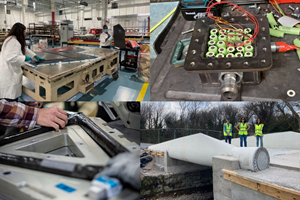Home building with composites
There’s a house being built next door. It could be using more composites.

Source | CW
My wife and our three boys moved into our current home in 2003. It’s located in a somewhat rural area of Colorado in the United States, and the entire time that we have lived here the lot next door has been vacant — which we have enjoyed, from a privacy perspective.
That all changed a few months ago when a local home builder bought the property and began construction. The work started in March with the excavation of a basement, followed by the setting of forms for the concrete foundation. Next came the pouring of concrete, removal of the forms, the pouring of the basement floor and then, just this week (mid-August), the start of framing.
I met the home builder and have talked to him a couple of times. He told me he’s been building houses in this area for 20 years, and like most custom home builders, he has a few standard home designs (called “spec” homes) that he builds most often. The house he is building next to us is one such spec home.
Because I work from a home office, I am keenly aware of the comings and goings of workers and the construction activity next door. Observing this activity, I have developed a couple of observations.
First, construction of the concrete foundation next door has proved incredibly inefficient. It took three to five workers two weeks to set all the forms, another week before concrete was actually poured into the forms, a few days for the concrete to set, and then another week to remove the forms. That’s a month to build the foundation.
All of this got me to wondering if there is an opportunity here for composites.
Second, at the risk of stating the obvious, framing and roofing a house such as the one next door (or our own house, for that matter) requires a substantial amount of wood products, which of course must be harvested from trees. Even if we humans are doing a better job than ever managing and replanting our forests, the world still consumes 15 billion trees each year, while planting only 5 billion. That’s not sustainable.
All of this got me to wondering if there is an opportunity here for composites. Or, rather, I know there’s an opportunity here for composites, but I wonder how viable it is. Take, for example, the foundation of the house next door. Could it not be made with prefabricated composite panels? It can. You might recall, at the very first CAMX in 2014, the winner of the CAMX Unsurpassed Innovation Award went to Composite Panels System LLC (Eagle River, Wis., U.S.), for its 9-foot Epitome foundation walls, which provide R-16.5 insulation value, integrated stud cavities for mechanicals and inherent damp-proofing. More importantly, they can be fabricated offsite and then installed in just a few days, obviating the need for the forms required of a concrete foundation.
The same opportunity exists for composites use in the walls of the house itself. There are, already, many suppliers of prefabricated composite wall systems that are being used in residential construction applications.
This is such a good fit for composites use that it’s a wonder we don’t see composite foundations and walls all across the world. The problem, of course, is not that composites are not a good fit for the application. The problem, as usual, is inherent favoritism for incumbent materials (concrete and wood) and the natural tendency among us humans to resist change.
There is also an implementation problem. It would take a bold and innovative home builder to decide to start constructing foundation walls with composites. It would also require a willingness to understand and embrace a new material, and then implement specialized training of subcontractors for the use and installation of composite wall systems. This would be a challenge in any case, but particularly in a business where home builders sometimes struggle just to get subcontractors to show up. Case in point: I heard the contractor next door on the phone this morning asking his framing subcontractors where they were.
None of this is to say that composites don’t have a future in residential building and construction, because they obviously do. But there are hurdles to clear, and getting over them them will take time and effort. And then, one day, I hope I can share a photo of a home being built nearby with a composite foundation.
Related Content
How has CW changed in the last year?
Upon his one-year anniversary as editor-in-chief of CW, Scott Francis looks back at some of the brand’s changes and hints at where it might be heading next.
Read MoreAs 2023 begins, a look back at trending CW topics in 2022
With 2022 now behind us, CW’s editor-in-chief Jeff Sloan takes a look at the CW stories last year that received the most reader attention.
Read MoreHow composites have become a necessity
Composites used to be one of many material options across industries and applications, but that's not the case anymore.
Read MoreLooking at composites through the lens of U.S. history
When you’re a tourist with a background in writing for manufacturing it’s impossible not to notice all of the ways in which composites have resulted in significant milestones in the U.S. — historically and in the present.
Read MoreRead Next
Corvette, yesterday and today
The Corvette has changed much in 67 years, but its appeal is enduring.
Read MoreDeveloping bonded composite repair for ships, offshore units
Bureau Veritas and industry partners issue guidelines and pave the way for certification via StrengthBond Offshore project.
Read MorePlant tour: Daher Shap’in TechCenter and composites production plant, Saint-Aignan-de-Grandlieu, France
Co-located R&D and production advance OOA thermosets, thermoplastics, welding, recycling and digital technologies for faster processing and certification of lighter, more sustainable composites.
Read More












.jpg;maxWidth=300;quality=90)








